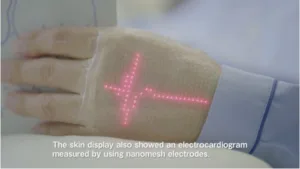Prof. Takao Someya from the University of Tokyo demonstrated a fully flexible display in an interview published by EurekaAlert!. The group at the University of Tokyo has been working on this for years with first announcements going back several years. While originally they used a segmented OLED display, this time they are using a low resolution matrix display based on micro LEDs. Combined with a stretchable backplane they created a wearable display as shown in the image.
Stretchable microLED display demonstrated by Prof. Takao Someya, Univ. Tokyo
With a resolution of 24 x 16 pixel, this is by no means a replacement for a high resolution smartphone display. Nevertheless, the display is built on a transparent film that can be attached directly to the skin of a patient and stay there for a week without causing inflammation. The display can be stretched by up to 45% of its original length without losing its functionality.
In this application, they added sensors that measure the wearer’s heart beat and displays it on the micro LED matrix. (NH)
Analyst Comment
This is the first ‘display’ that deserves to be called flexible. With its stretchable architecture based on a network of stretchable wiring, this is a first step into a wide array of applications that could benefit from such displays. while it is not clear how the display is powered (battery in the sleeve?) this is truly a remarkable development. It seems unlikely that this technology will find a widespread application in consumer electronics, specialty applications like the medical field can great benefit from it. (NH)

